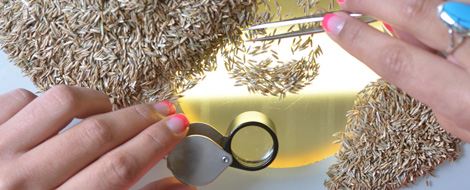
All States Noxious Exam: to determine the presence of all states (except HI) noxious weeds and the estimate rate of occurrence in the seed lot based on a minimum of 25,000 seeds. This test is conducted when an AOSA purity is requested.
Agri Tag: all crop and weeds found in the test are reported on an Agri Tag report. The number of crop or weed seeds found and the number seeds per pound are reported.
Undesirable Grass Seeds (UGS): the following seeds are considered UGS in some eastern states: Bermudagrass, Annual Bluegrass. Rough Bluegrass, Bentgrass, Meadow Fescue, Tall Fescue, Orchardgrass, Timothy and Velvetgrass. The UGS found and the number per pound is reported in the Noxious section of the Analysis report when a purity is conduced or in the Other Seed Determinations section.
Cleaner Check: a quick test to help the cleaner know if the machines are set correctly. Two components, pure seed and everything else based on 1 gram.
Mill Check: a quick test to determine inert matter percentage for cleaner. Based on 2,500 seeds, 4 part separation to check before conditioning to final quality.
Soil/Ergot/Sclerotia: is a visual test to determine the soil/ergot/sclerotia particles found in a working sample.
Pest & Disease: a visual exam to determine and report presence of listed pest and disease in a submitted sample.
AOSA Seed Count: to determine the approximate number of seeds per pound. Eight reps of 100 seeds are weighed and the variance, standard variation and coefficient of variation are calculated for assurance of the determination to be calculated.
Seed Endophyte: detects the presence or absence of endophyte fungi (Neotyphodium spp.) in seeds of various grass species such as Tall Fescue and Ryegrass. Seed test only shows presence of fungi, not viability of fungi.
Field Tiller Endophyte: detects presence of endophyte in grass plant tillers from a field.
Growout Tiller Endophyte: detects the presence of live endophyte in seedling tillers from a grass growout.
Germination (400 Seeds): to determine the ability to produce a normal plant under favorable conditions.
Growout (6 weeks): growout in soil of fluorescent ryegrass seedlings to differentiate between Annual and Perennial types.
Ryegrass Fluorescence: to distinguish the percentage of perennial vs. annual. This test is required for labeling ryegrass. A fluorescence test is automatically conducted when a germ is requested, if a purity test has been conducted or requested at the same time.
1200 VFL: to determine the percentage of varietal fluorescence of Ryegrass. There must be at least 3 lots form at least 2 generations; one generation must be breeder seed. There must be at least 25 fluorescent seedlings tested from at least 3,000 seeds with at least 1,000 from each lot, maximum of 10,000 total. If 25 total fluorescent normal seedlings are not obtained after testing 10,000 seeds, whatever number obtained will be acceptable. www.aosca.org/varietyreviewboards/grass/grass.html
Ammonia Test: to distinguish between red fescue and sheep or hard fescue. This test is performed on all samples submitted as Hard or Sheep Fescue for germination and purity tests.
Ploidy by Cytometry: this test can determine the ploidy level of a tissue sample in most cases for Diploid and Tetraploid DNA content.
Tetrazolium Test: a quick test that can determine the viability of ungerminated seeds, the percentage of dormant seed when a separate germination test is required, the estimate viability of a seed lot before completion of a germination test or estimate viability independently of a germination test.
Ferric Chloride: a fast and useful test that provides a rapid estimate of the percentage of abnormal seedlings expected from a crop. Mechanically injured legume seeds turn black when placed in solution of ferric chloride. The seed is placed in a 20% solution of FeCl2 for 15 minutes, at which time all black staining seeds are separated.
Purity on Pelleted, Encrusted or Coated Seed: the weight of the working sample is determined separately for each lot following the AOSA rules. Seed is washed, dried over night and purity rules followed. Percentage of coating material is reported under Other Determinations on the Report of Analysis.
